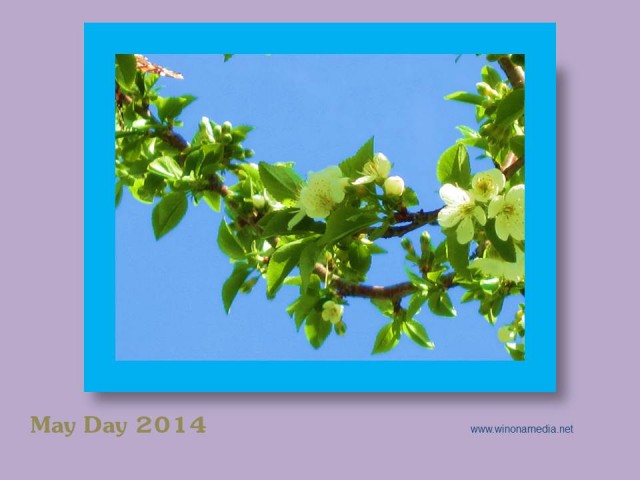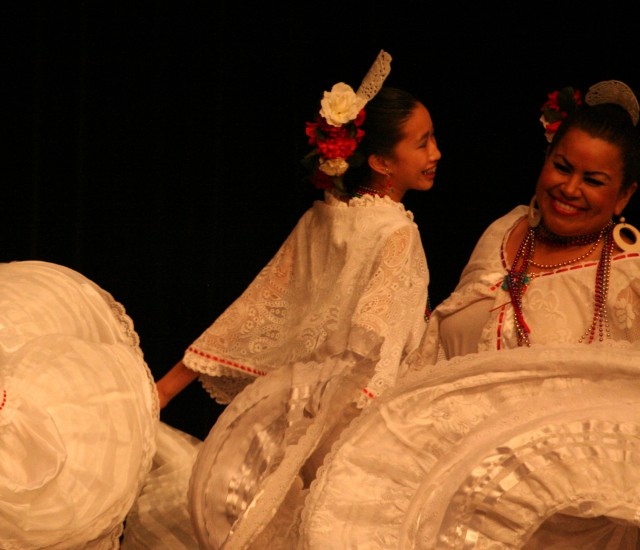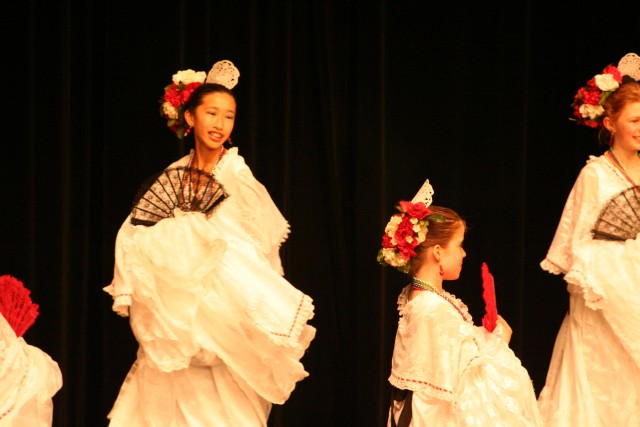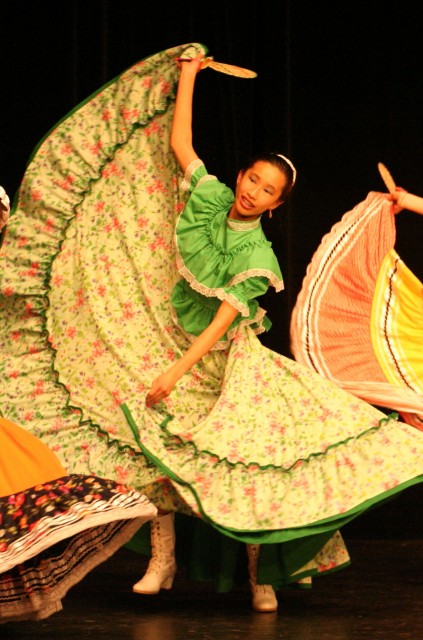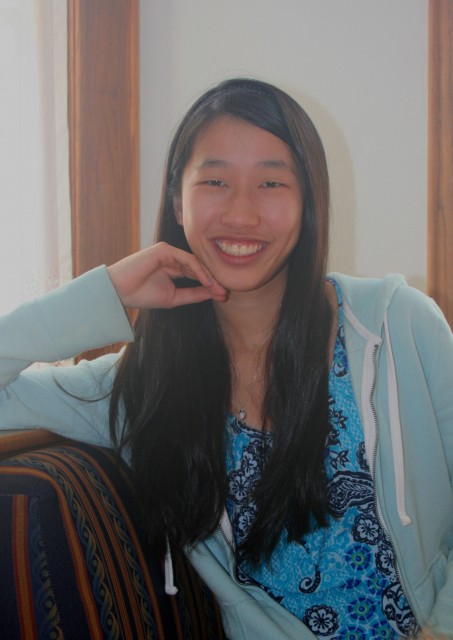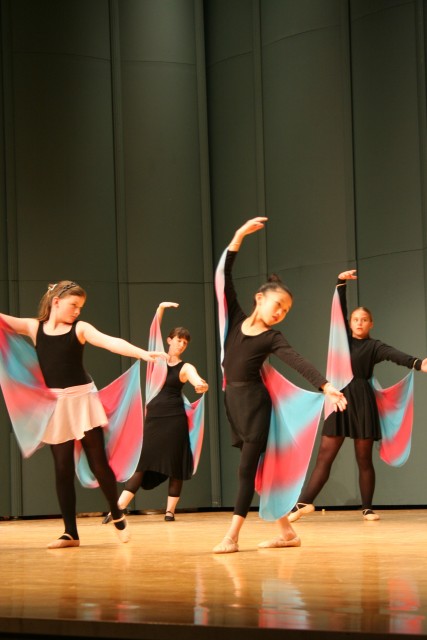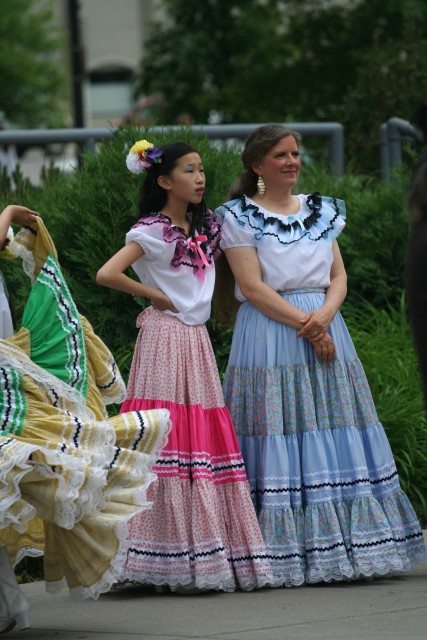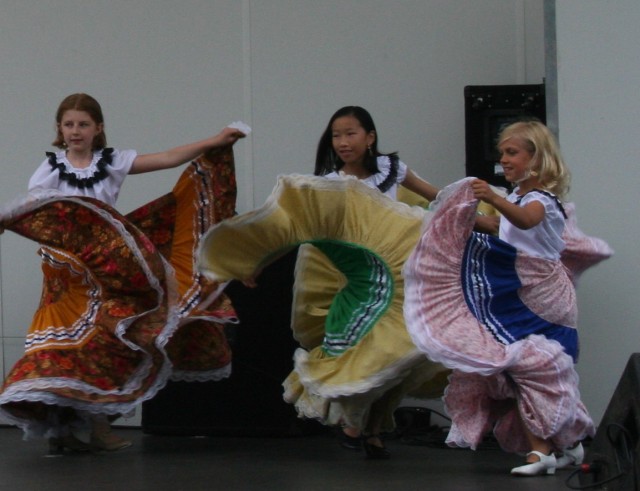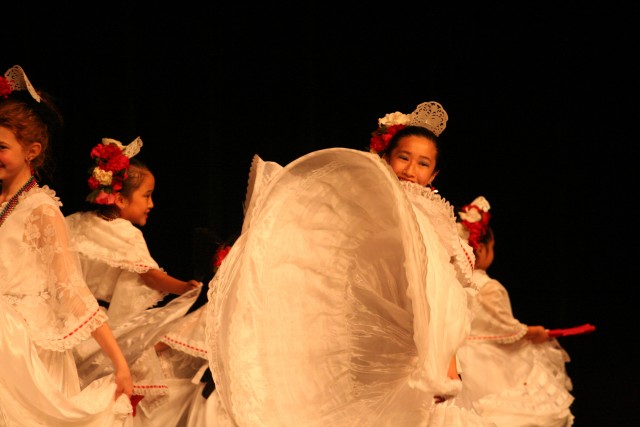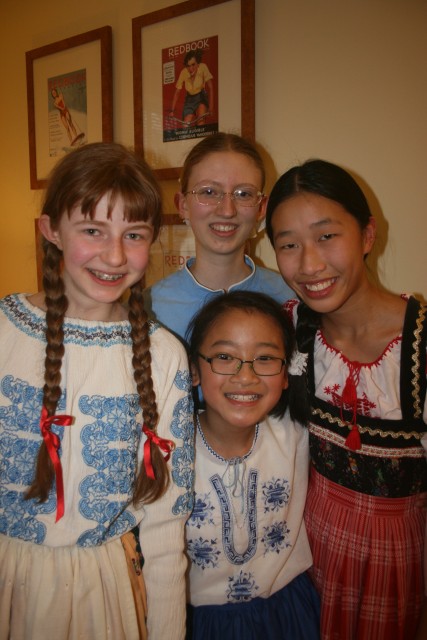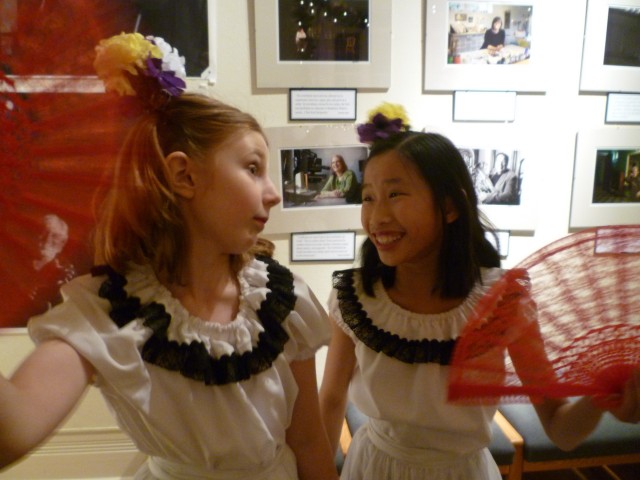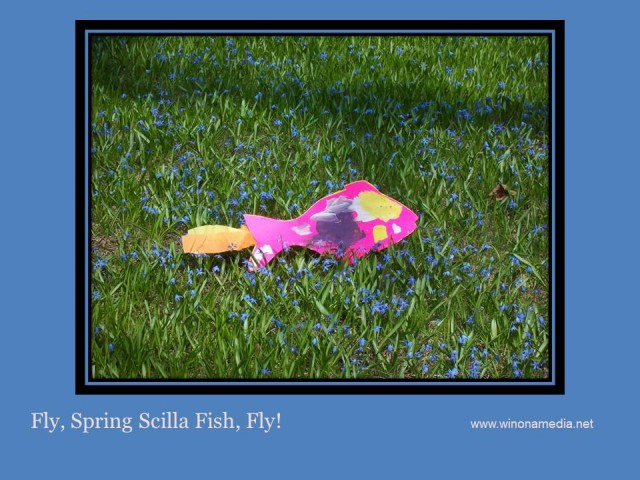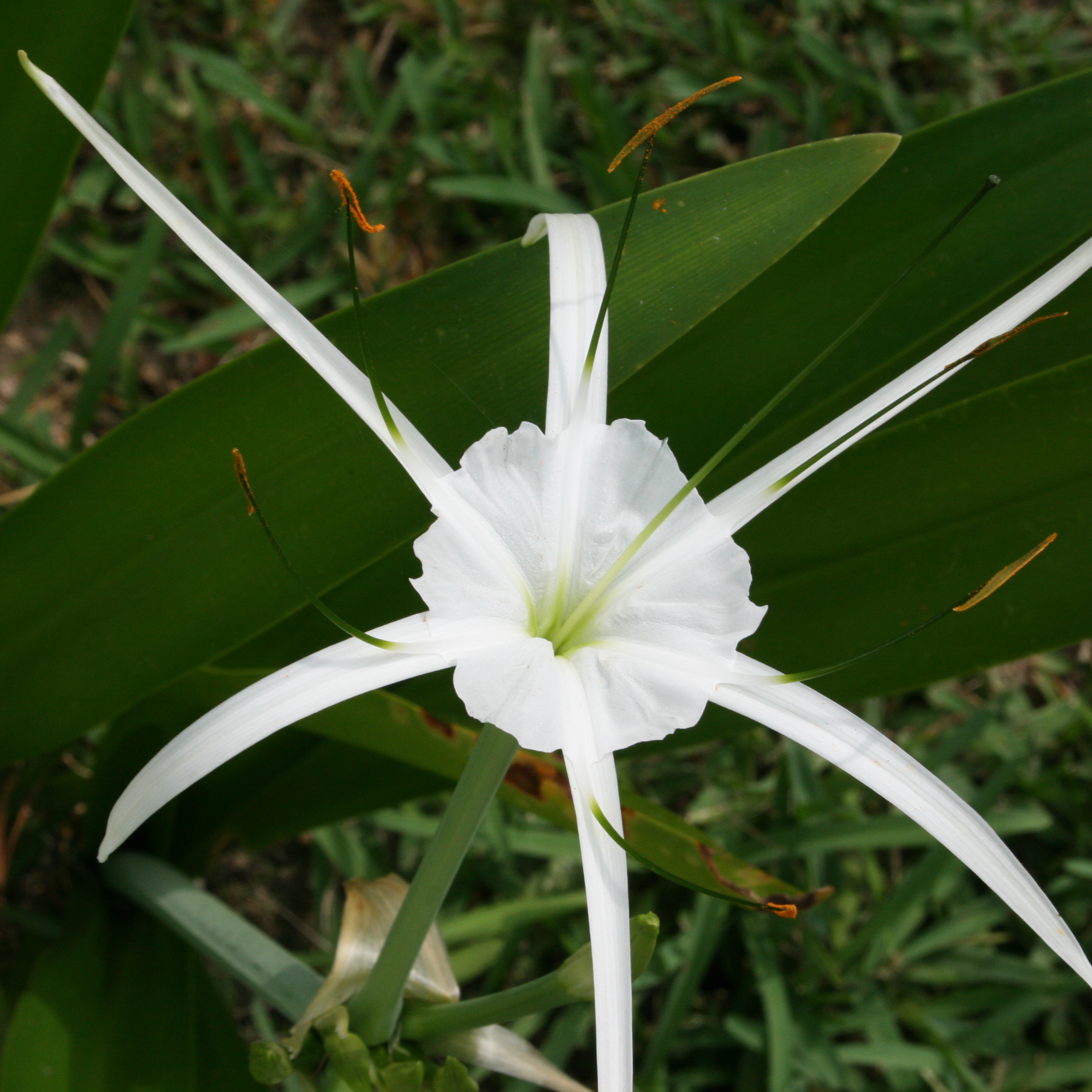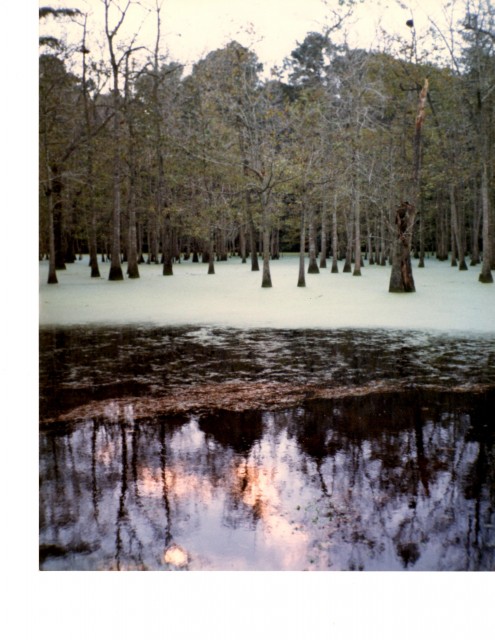Monthly Archives: April 2014
Stomps, Swirls, & Skirt Work: Interview with Dancer Atia Cole
For the past six years, I have received an education (from the sidelines) of the vibrant, joyful intricacies of Mexican Ballet Folklorico. In addition to learning about the traditional dances of several Mexican states, I have been able to watch the evolution in skill and confidence of Atia Cole, who is now a veteran dancer with eight consecutive years—more than half of her life—in the Northfield Arts Guild program founded nine years ago. Atia has also explored a number of other dance traditions, including world folk dance, (Chinese, Israeli, Bulgarian, Scandinavian,and Romanian) Indian dance, the dances of Jane Austen, modern dance, and ballet. In 2013, she participated in a workshop with the celebrated Ragamala Dance Theater on classical Indian dance.
Welcome, Atia! Would you share with Winona Media readers what your interests are and what draws you to dance?
Sure! I like to read the Warriors series, the Lord of the Rings series, and I have read the whole Harry Potter series. I like Jane Austen—the movies have made me interested and now I am reading her novels. For anyone who hasn’t seen it, I recommend the Bollywood adaptation, “Bride and Prejudice”. I like the coast of Maine. I love being by the ocean and the rustic scenery. It is very peaceful. I am especially fond of Monhegan Island. I used to want to be a vet, but I am leery of surgery and seeing blood on a regular basis, so I am less sure that I will go into veterinary science. I am still drawn to work with animals, though. I might become a dog trainer.
In terms of my studies, I like science and English best. I especially like creative writing. (Note to readers: Atia’s fine poem, “Forest Crafted of Ice”, was recently published in the regional anthology, Wordflow and can be found in the April 1, 2014 post.) I love drawing, folk dance, playing the recorder, and horseback riding. Math and Chinese are subjects I have to work at.
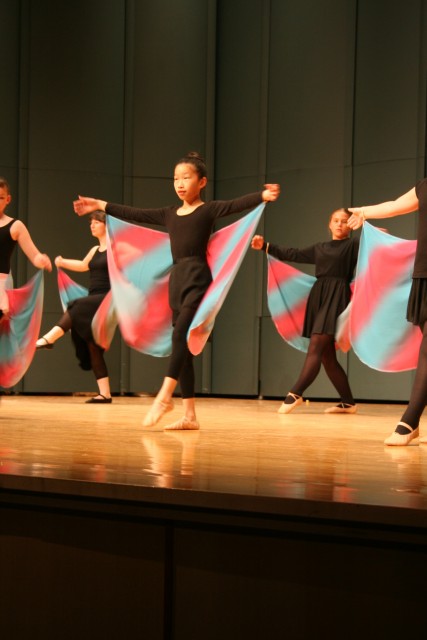
Do you remember your first exposure to dance?
I remember being part of a summer ‘Chance to Dance’ camp at the Northfield Arts Guild when I was about five years old. It’s funny but I don’t remember dancing. What I do remember is seeing this girl—Julia, who has turned out to be a very good friend—and really admiring the leotard she was wearing. It was royal blue and had a chiffon skirt that floated.
I like being on stage when I am dancing, not if I am in a play with lines to say. Dancing just makes me happy. And I have two great teachers, Ana Baez, who has decades of professional experience in Mexican Ballet Folklorico, and my mom, Kate Stuart, who knows about (and teaches) many folk dance traditions and is the assistant teacher for Ana. (Mom also makes and cares for the amazing costumes we wear.)
What is it like to wear those costumes?
I love to wear them, and they are essential to creating the dances. Part of what we do is called “skirt work”, which means lifting and moving the skirts. In Sinaloa dances, for example, which is near the sea, we move the skirts to make them look like waves. We use the skirts to add more to the dances, to amplify the sounds and movements we make with our feet. The skirts are so long that most of the time our feet cannot be seen, just heard. Without a skirt, say if the dancers were wearing leotards, the movements would be meaningless: our hands would be clenched and our arms would be lifting and swinging in air. It would look odd. Mexican Ballet Folklorico dances tell cultural stories, and the skirts are part of that. With skirts, we can create dramatic movements and shapes, as in plate turns. Even in classes and for practices we put on ‘practice skirts’. We save the actual costumes for the performances.
What dance challenges have you mastered? Which ones are you working now to refine?
The first year that we learned the dances from the state of Nayarit, Anna didn’t teach us the plate turn. Most of us were very young. Our arm muscles weren’t developed, so we couldn’t hold all of the cloth up and still move our feet in the right way. We just sort of shuffled around the stage. The next time we did the Nayarit dances, maybe two or three years ago, she taught us the plate turn. We could do it. Even though it looked sloppy, not crisp the way Ana does it, we all had fun with it. I am still working on it. I am learning just when to raise and drop my arms. If the dancer is a half-a-beat off, the skirt doesn’t look like a plate when the turn happens. Of course, Ana is a master. It is so inspiring to see her slip into the plate turn so effortlessly! 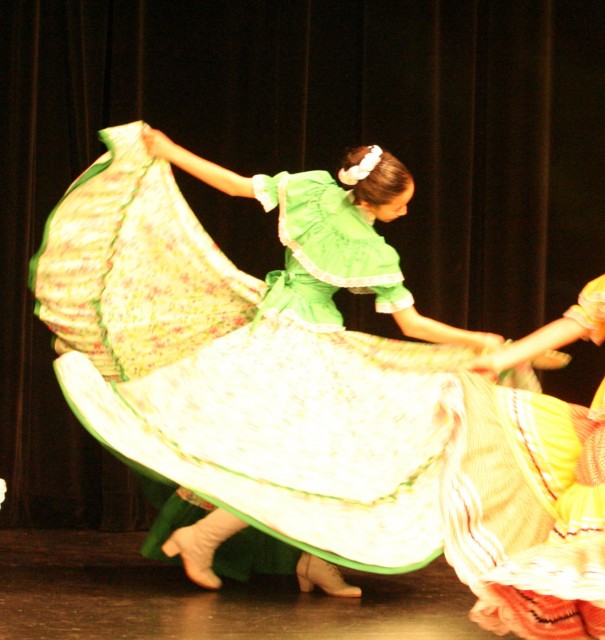
A benefit of years of practice?
Definitely.
We also did a dance last year from Veracruz which was challenging in two ways. In that dance there is no music. All the sounds come from our feet, so any mistakes are much more audible and obvious. If one dancer is off, she can throw everyone else off. To amplify the sound, we danced on wooden boxes, about eight inches from the floor. They provided each dancer with her own small stage, about two feet square. After first, I felt very timid because I didn’t want to fall off. That’s never happened but it still scared me a bit. Now I am more used to it. When I last performed that dance, I was able to be more open, and not to look down or look worried. 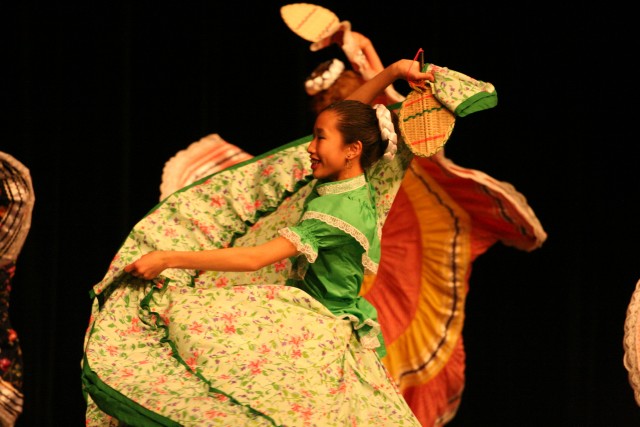
I have noticed that confidence in dancers seems to move from the feet, up through the torso, into the arms and shoulders, and finally into the head. From what I have noticed, the face is that last place to be relaxed, smiling. I think you have achieved that. What do you think?
I don’t know. Maybe!
When we first start working on dances from a new region, I feel very self-conscious about how I look. Partly because the teachers are pointing out lots of things I am doing wrong. They have to, but it is hard to accept corrections. Then, with practice, I start to feel more confident. More graceful and fluid, I guess.
Speaking of ‘fluid movement’, you have mastered a dance in which there is a glass of water on your head. What was that process like?
That was really challenging at first! Gradually, we all found we could loosen up, replace timid, tiny steps with rapid, self-assured steps. That dance is one where you have to think about the connection between what you are doing with your feet and how you are holding your head!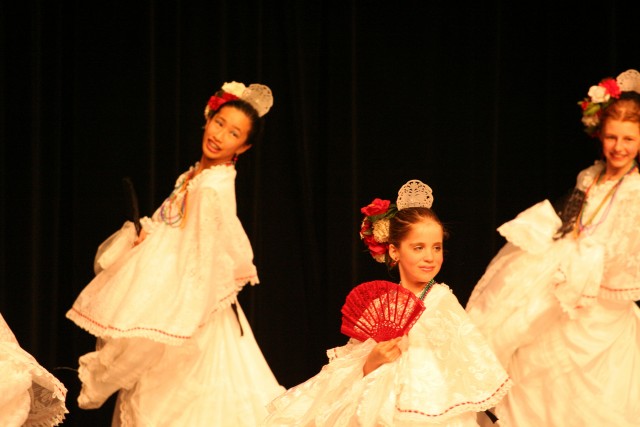
Over the past eight years, you’ve explored dances from Nuevo León, Nayarit, Veracruz, Sinloa, Tamaulipas, Durango, Jalisco, and Tabasco—each with a distinctive style. Do you have a favorite style?
I really like the one we are working on now, Tabasco, because I like to learn new things.
Do you ever get stage fright?
Yes, sometimes. Right before a performance starts. But that fear goes away when I start to dance. 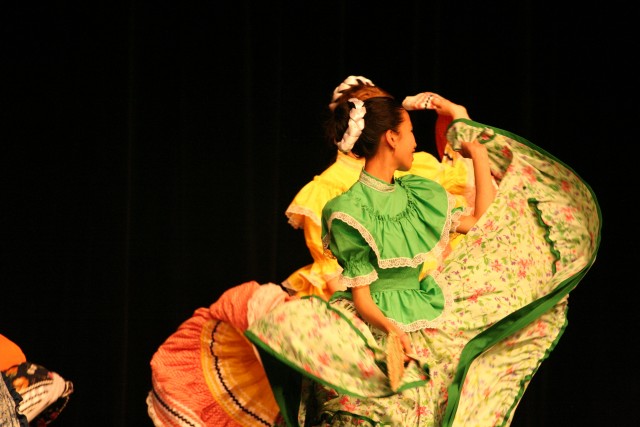
How do you feel after a performance?
That depends on two things: how the performance went and which performance it was. Sometimes we’ll make mistakes that never happened in practice. If something goes wrong, I am not as happy. And when it is the May recital, something we work toward all year, it matters all the more. But I really love to dance in front of an audience so they can see what we’ve been working on.
Has your Mexican Folklorico dance help you learn any Spanish or anything about Mexican culture?
I have only learned a few words of Spanish. I think I have learned more about Mexican culture from the people in some of the places where we have been invited to dance. For example, my first performance was in December 2006 for the Lady of Guadalupe. We first participated in a long procession in the parking lot, following her statue, and then sat through a two-hour long Mass in Spanish. And after we had a chance to taste some of the food. At these events, and at Cinco de Mayo, I am always surprised by how loudly the music is played. I suppose I have learned most about the culture of Mexican immigrants rather than the culture of Mexico itself, since I have never been to Mexico.
Are you thinking of exploring any other dance forms in the future?
I am not planning anything definite, but I am attracted to ballet and the way classical Indian dance is updated for Bollywood movies.
Thank you, Atia!
You’re welcome!
Note to readers in the Northfield area: the Northfield Arts Guild’s annual dance concert, held on May 17, 2014 at the Northfield High School auditorium, will showcase several dances from the local Mexican Folklorico company, as well as a variety of choreography from the other NAG dance programs. For more information and to order tickets, go to www.northfieldartsguild.org.
Postcard: April 28, 2014
Launching an Online Literary Review: Jan Rider Newman & Jessica Roach Ferguson of SWAMP LILY REVIEW
Have you ever fantasized about becoming a publisher? Most writers have. Here’s an interview with two talented and successful writers who teamed up to make the dream a reality.
Jan Rider Newman is a native of south Louisiana. Descendants of Acadians exiled from Nova Scotia, Spanish and French soldiers, Choctaw Indians and a lone Irishman, her family spoke Louisiana French as a first language. She grew up surrounded by rice fields and gravel roads, which she roamed all summer. Those landscapes, those people, their accents and voices, permeate her work.
Jan earned a Master of Fine Arts degree in creative writing after studying with Robert Olen Butler and John A. Wood. She has published short stories, poetry, and nonfiction and earned prizes for her work as well as grants from the Louisiana Council of the Arts. In another professional life she was a paralegal.
Jan publishes and co-edits the online literary journal, Swamp Lily Review (swamplily.com). She is working on a novel about the Acadian exile. Her website is janridernewman.com, and she blogs at “Beyond Acadia: Reading, Writing, & Living Well” (blog.janridernewman.com). She is a member of the Bayou Writers Group, She Writes, and Women’s Fiction Writers Association.
Jessica Roach Ferguson, born and raised in Texas, is also a long-time resident of Louisiana, is co-editor of Swamp Lily Review, A Journal of Louisiana Literature & Arts and writes for Southern Writers Magazine. She is the author of The Last Daughter, a novella available on Amazon. She worked as assistant editor/writer/photographer for The Times of Southwest Louisiana, and her work has appeared in magazines and newspapers in Louisiana and Texas. She is also the founder of the East Texas Writers Association in her hometown of Longview, Texas; a past president of Bayou Writers’ Group in Lake Charles, Louisiana; and founder of their annual Gator Bites publication. Find her blog at http://jessyferguson.blogspot.com.
You each had separate plans to launch an online literary review, so how did you decide to combine your visions?
Jan: My teacher and friend, Leo Marcello talked about printing a literary journal back in the late 1990s. The idea excited—I’d almost say infected—me and never went away, like a virus, only a good one.
Jess and I have been friends for many years, and used to belong to a critique group offshoot of our writers’ group. One day Jess mentioned someone’s idea to start a journal for publishing work from the group. Our reaction was that we were both interested in publishing a literary journal, but not for the group—for ourselves with wider submission policies. I actually have to give a lot of credit for the idea to Jessica, because she said she had been entertaining the idea too. So we dared to say . . . should we? Could we? Our writing styles are very different. We even work in different genres, but our editorial tastes run along similar, though not identical, lines.
Jess: I didn’t have actual plans, I just had the fantasy of owning a literary magazine. As far as I was concerned it was just that—a fantasy. It was a nice “place” to visit when I wanted an escape from my writing. I wouldn’t have pursued it if Jan hadn’t hopped on board. Once we shared our dreams, we prodded each other to actually create Swamp Lily Review. There’s something about having a partner that keeps one on the path to success. And, I do consider Swamp Lily Review a success.
Describe the dream: what did you set out to achieve?
Jess: I’m sure we both had different goals for Swamp Lily Review–our own personal goals. Jan comes from a more literary background while I’ve been known to chase the markets (something you’re not supposed to do), but we share a lot of the same likes. We both appreciate submissions that are well edited and grammatically accurate. I think we’ve each achieved our goals as far as the physical online journal itself.
I’d love to publish poets, fiction writers, memoirists for the very first time–give them their start. Every time a writer sees his or her name in print, it adds to their confidence as a writer. It’s affirmation that they’re on the right path with their writing. In a nutshell, I set out to help others get published.
Jan: Between us, Jess and I have a lot of writing and publishing experience and have developed our own sensibilities. As we state on our website: “We are diverse – we are creative – we are Louisiana. This diversity and creativity is what Swamp Lily Review wishes to celebrate and publish in two issues per year: what sets Louisiana apart from the rest of the U.S., and what makes us a part of this country.”
We wanted an online site where writers of all experiences felt welcome as long as they had good work to offer. Starting out regional, we hoped, and still do hope, to showcase Louisiana writers and visual artists. We have expanded, though, to include work from writers everywhere.
What was the learning curve like? How much time does it take to create two issues a year? Have your roles as publishers affected your work as artists?
Jess: I’ll be the first to admit, Jan does all the work. She created our website. When I moved to Oklahoma for sixteen months, she became the first reader on top of everything else she does. She really is Swamp Lily Review. She put a lot of effort into learning how to make SLR look professional.
I had a problem learning how to respond to those who submitted to us. Sometimes they’d have a beautiful poem that was ruined by one stanza. Or they’d send a short story that missed the mark because they didn’t delve deep enough. I have a bad habit of wanting to critique or go into detail in my rejections. Being a writer with my own share of rejections, I definitely identify with everyone who submits. I can visualize them waiting for a reply and how they must feel if and when we reject them. I hate rejecting anyone. The only time I get frustrated is when they don’t read our guidelines–and it’s very obvious when they don’t. As an artist, I always study guidelines and read samples of what other magazines publish. As a publisher, I’m learning to identify with other publishers.
Jan: Oh, the learning curve! It’s still on the rise; at least, I hope it is. At first, for me, it was learning how to put together the website physically so it looked professional and attractive. That took a long time for someone who had never even tried such a thing. I learn new ways to present the site with every issue. However, the best thing I’ve learned is to keep it simple and showcase the work itself. Deciding what to publish from the stories, poems, and visual art submitted is a developing art in itself and a balance of respect for submitters and submissions and what is and isn’t right for SLR—a humbling task.
I’ve had fun, too, with a submitted story or book review that needed some tweaking and editing to make it publishable. Editing is a delicate dance between editor and writer, and I had the good fortune of working with two receptive reviewers for the last issue of Swamp Lily, writers who knew when to yield to my judgment and when to stand their ground.
If my writing has been affected by the role as editor, I think it’s made me more aware of what sort of stories are being told and poems are being written now. My style is often not “in step”—which isn’t bad, just challenging. I also have a better sense of how my work is being viewed on the receiving end when I submit.
Knowing what you know now, would you do anything differently?
Jan: I don’t think I would. We did what we had to, just blundering ahead with our eyes on the prize, hope as our guide.
Jess: I wouldn’t change a thing. Well, maybe I’d learn how to create a website. That might come in handy.
What goals–and dreams–do you have for SLR now?
Jan: My goals are to get better as an editor and a user of websites in general. For Swamp Lily I dream of nominating an author for a Pushcart Prize. I’d love to see more fiction, creative nonfiction, and book reviews. Side note: I’ve been shocked to find out many authors don’t know what book reviews are. We get unsolicited books, queries about reviewing authors’ books for them, or offers to send reviews of their books, i.e., they think we will publicize their work.
Jess: I’d like to see SLR grow–get bigger and better. We’ve yet to receive any creative nonfiction so I’d definitely love to receive some great stories. Your own story, Leslie, “The Damages”, read so much like creative non-fiction to me, I would have argued it was true. That’s exactly what I’d like to see in creative non-fiction submissions: true stories that tug at the reader’s heart, teach them something and stay in their memory for months and years to come, stories that leave a trace of sadness behind, but also an understanding that there could be no other resolution or outcome. But on the flipside, I love to laugh too!
What are your thoughts on the relative merits/disadvantages of print vs electronic reviews? Electronic versus print publishing in general?
I have a novella out now as a digital book. Breaks my heart that I can’t hold it in my hands in print form, but electronic everything is here to stay whether I like it or not, so I’m jumping on board. There are a lot of opportunities in the so-called e-world. Sadly, I have writer friends who have given up their writing because of how the publishing world has changed. I hate that for them. I don’t understand most of what’s happening in this electronic age. I’m certainly not where I can format my own ebook, or take on SLR if Jan ever walked away from it. I have a tenuous hold on my writing future. I’m hanging on though… and having fun.
I hope your readers will connect with me on Twitter @jessyferguson, on Facebook, LinkedIn and Pinterest. We can all encourage each other.
Jan: Electronic publishing has the merit of being a new, wide-open medium where anyone can publish, which is also its disadvantage. But it isn’t a much different experience from walking into a bookstore whose shelves are crammed with books and magazines and sorting through the mass for something you like. The expense of paper publication is off-putting and would make publishing a little journal like ours prohibitive. On the other hand, I do, like Jess, love holding a hard copy book or magazine in my hands. We live in a world where we can access our reading material on our home computers and go out to a library or bookstore. What’s not to like? I leave wiser, more experienced writers to comment on the effect of electronic publishing on authors’ rights and royalties.
Thank you both so much for taking the time to answer these questions!
NOTE: The next issue of Swamp Lily Review is due out in June 2014. Check out their back issues here. I can attest to the literary skillfulness of both these authors. Intrigued? Take a look at Jess’s romantically eerie mystery new Kindle novella, The Last Daughter, and Jan’s deeply felt and beautifully short story collection, A Long Night’s Sing both on amazon.com!
 Thank you for reading this! If you think of someone else who might enjoy it, please forward it to them. And, if you are not already a subscriber, I invite you to subscribe to the Wednesday posts I am sending out each week–it’s easy, it’s free, and I won’t share your address with anyone!
Thank you for reading this! If you think of someone else who might enjoy it, please forward it to them. And, if you are not already a subscriber, I invite you to subscribe to the Wednesday posts I am sending out each week–it’s easy, it’s free, and I won’t share your address with anyone!

